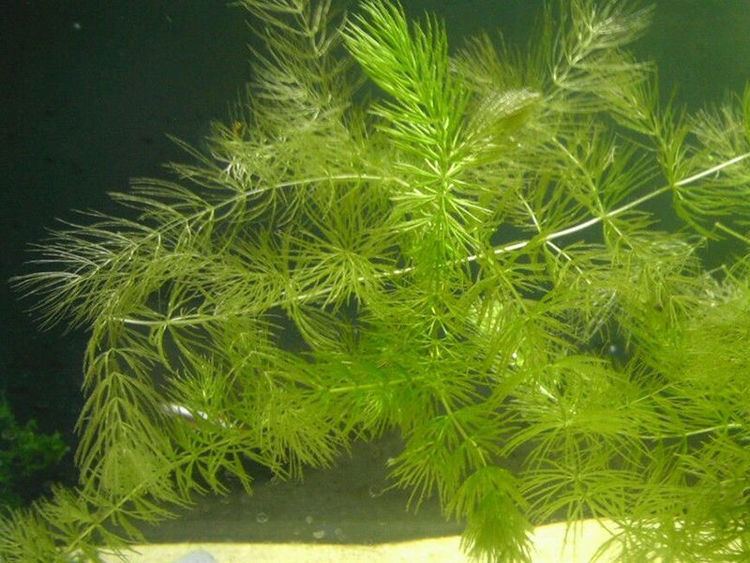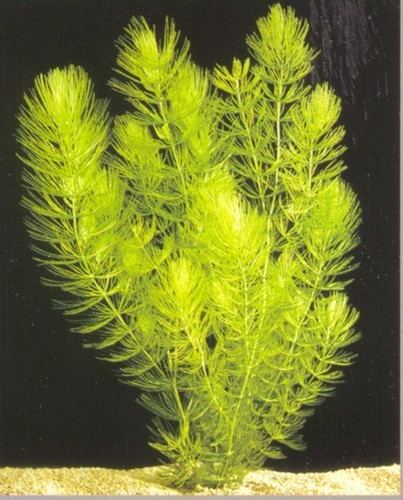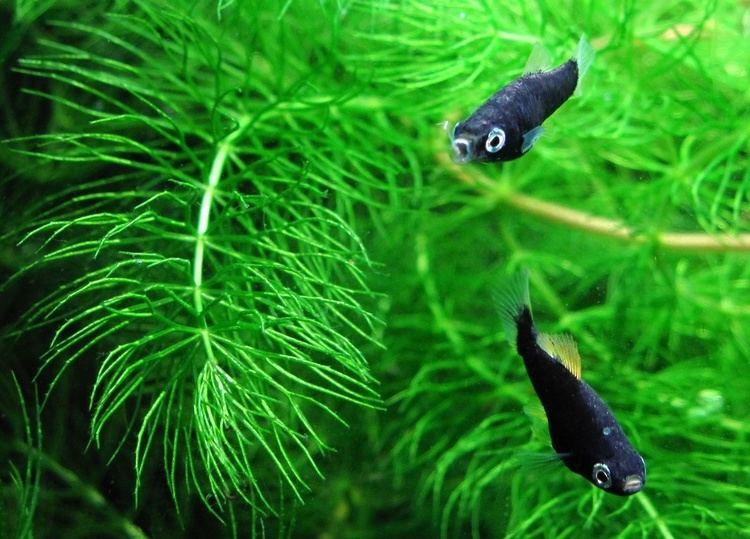Kingdom Plantae Higher classification Anthocerotophyta | Scientific name Anthocerotopsida Rank Class | |
 | ||
Division AnthocerotophytaStotler & Stotl.-Crand., 1977 Similar Liverworts, Anthoceros, Lycopodiophyta, Moss, Marchantia | ||
Hornworts are a group of non-vascular plants comprising the division Anthocerotophyta. The common name refers to the elongated horn-like structure, which is the sporophyte. As in mosses and liverworts, the flattened, green plant body of a hornwort is the gametophyte plant.
Contents

Hornworts may be found worldwide, though they tend to grow only in places that are damp or humid. Some species grow in large numbers as tiny weeds in the soil of gardens and cultivated fields. Large tropical and sub-tropical species of Dendroceros may be found growing on the bark of trees.

Hornwort a pest plant
Description

The plant body of a hornwort is a haploid gametophyte stage. This stage usually grows as a thin rosette or ribbon-like thallus between one and five centimeters in diameter. Each cell of the thallus usually contains just one chloroplast. In most species, this chloroplast is fused with other organelles to form a large pyrenoid that both manufactures and stores food. This particular feature is very unusual in land plants, but is common among algae.

Many hornworts develop internal mucilage-filled cavities when groups of cells break down. These cavities are invaded by photosynthetic cyanobacteria, especially species of Nostoc. Such colonies of bacteria growing inside the thallus give the hornwort a distinctive blue-green color. There may also be small slime pores on the underside of the thallus. These pores superficially resemble the stomata of other plants.
The horn-shaped sporophyte grows from an archegonium embedded deep in the gametophyte. The sporophyte of a hornwort is unusual in that it grows from a meristem near its base, instead of from its tip the way other plants do. Unlike liverworts, most hornworts have true stomata on their sporophyte as mosses do. The exceptions are the genera Notothylas and Megaceros, which do not have stomata. The sporophyte of most hornworts are also photosynthetic, which is not the case with liverworts.
When the sporophyte is mature, it has a multicellular outer layer, a central rod-like columella running up the center, and a layer of tissue in between that produces spores and pseudo-elaters. The pseudo-elaters are multi-cellular, unlike the elaters of liverworts. They have helical thickenings that change shape in response to drying out; they twist and thereby help to disperse the spores. Hornwort spores are relatively large for bryophytes, measuring between 30 and 80 µm in diameter or more. The spores are polar, usually with a distinctive Y-shaped tri-radiate ridge on the proximal surface, and with a distal surface ornamented with bumps or spines
Life cycle
The life of a hornwort starts from a haploid spore. In most species, there is a single cell inside the spore, and a slender extension of this cell called the germ tube germinates from the proximal side of the spore. The tip of the germ tube divides to form an octant (solid geometry) of cells, and the first rhizoid grows as an extension of the original germ cell. The tip continues to divide new cells, which produces a thalloid protonema. By contrast, species of the family Dendrocerotaceae may begin dividing within the spore, becoming multicellular and even photosynthetic before the spore germinates. In either case, the protonema is a transitory stage in the life of a hornwort.
From the protonema grows the adult gametophyte, which is the persistent and independent stage in the life cycle. This stage usually grows as a thin rosette or ribbon-like thallus between one and five centimeters in diameter, and several layers of cells in thickness. It is green or yellow-green from the chlorophyll in its cells, or bluish-green when colonies of cyanobacteria grow inside the plant.
When the gametophyte has grown to its adult size, it produces the sex organs of the hornwort. Most plants are monoicous, with both sex organs on the same plant, but some plants (even within the same species) are dioicous, with separate male and female gametophytes. The female organs are known as archegonia (singular archegonium) and the male organs are known as antheridia (singular antheridium). Both kinds of organs develop just below the surface of the plant and are only later exposed by disintegration of the overlying cells.
The biflagellate sperm must swim from the antheridia, or else be splashed to the archegonia. When this happens, the sperm and egg cell fuse to form a zygote, the cell from which the sporophyte stage of the life cycle will develop. Unlike all other bryophytes, the first cell division of the zygote is longitudinal. Further divisions produce three basic regions of the sporophyte.
At the bottom of the sporophyte (closest to the interior of the gametophyte), is a foot. This is a globular group of cells that receives nutrients from the parent gametophyte, on which the sporophyte will spend its entire existence. In the middle of the sporophyte (just above the foot), is a meristem that will continue to divide and produce new cells for the third region. This third region is the capsule. Both the central and surface cells of the capsule are sterile, but between them is a layer of cells that will divide to produce pseudo-elaters and spores. These are released from the capsule when it splits lengthwise from the tip.
Evolutionary history
While the fossil record of crown group hornworts only begins in the upper Cretaceous, the lower Devonian Horneophyton may represent a stem group to the clade, as it possesses a sporangium with central columella not attached at the roof. However, the same form of columella is also characteristic of basal moss groups, such as the Sphagnopsida and Andreaeopsida, and has been interpreted as a character common to all early land plants with stomata.
Classification
Hornworts were traditionally considered a class within the division Bryophyta (bryophytes). However, it now appears that this former division is paraphyletic, so the hornworts are now given their own division, Anthocerotophyta (sometimes misspelled Anthocerophyta). The division Bryophyta is now restricted to include only mosses.
Traditionally, there is a single class of hornworts, called Anthocerotopsida, or older Anthocerotae. More recently, a second class Leiosporocertotopsida has been segregated for the singularly unusual species Leiosporoceros dussii. All other hornworts remain in the class Anthocerotopsida. These two classes are divided further into five orders, each containing a single family.
Among land plants, hornworts appear to be one of the oldest surviving lineages; cladistic analysis implies that the group originated prior to the Devonian, around the same time as the mosses and liverworts. There are only about 100 species known, but new species are still being discovered. The number and names of genera are a current matter of investigation, and several competing classification schemes have been published since 1988.
Structural features that have been used in the classification of hornworts include: the anatomy of chloroplasts and their numbers within cells, the presence of a pyrenoid, the numbers of antheridia within androecia, and the arrangement of jacket cells of the antheridia.
Phylogeny
Recent studies of molecular, ultrastructural, and morphological data have yielded a new classification of hornworts.
